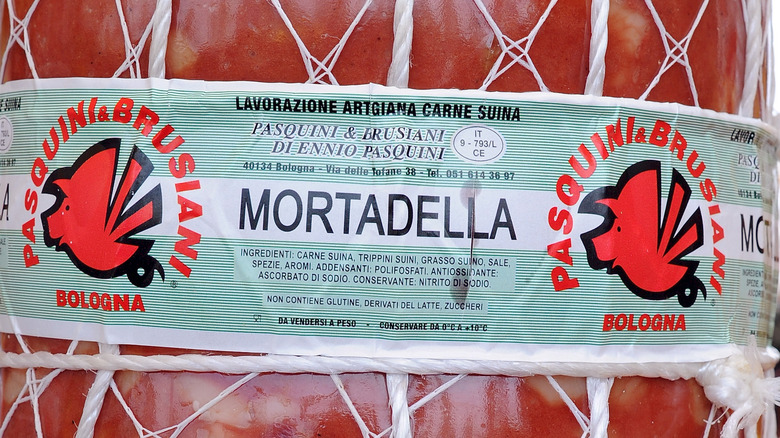The Difference Between Mortadella Di Campotosto And Mortadella Di Prato
Though Italy may be a single, unified country, its regions maintain distinctive characters. This is especially true when it comes to food and wine. Just as the culinary and cultural heritage of Alabama differs from that of Massachusetts, so too do cultures and culinary preferences change throughout the 20 regions of the Italian peninsula. Though regionalism has been criticized by the EU Observer as being an inefficient model of governance and causing economic disparity between north and south, from a culinary standpoint, you can determine where you are in Italy just by eating the food. No map required.
Mortadella is a prime example of unity through regionalism. This iconic salami is representative of all of Italy, thanks in part to Sofia Loren. Yet, regional differences exist in both the character and flavor of this beloved cured meat. Born in the city of Bologna, the capital of Emilia-Romagna, mortadella can be split into three distinct varieties. There is the classic mortadella di Bologna, and two lesser known, but no less flavorful, varieties: mortadella di Campotosto and mortadella di Prato (via MasterClass).
The latter two mortadellas are drastically different both from each other and their ancestral, Emilian classic. Influenced by the flavors and environments of Abruzzo and Tuscany, these two sausages shine a light on the culinary diversity that regionalism keeps alive through tradition and pride.
Abruzzo's mortadella di Campotosto
Abruzzo is an ecologically diverse region made up of mountains, valleys, and rugged Adriatic shoreline. It's known for Montepulciano d'Abruzzo, an acidic red wine known for its simplicity and flavor, per Decanter. It is no surprise, therefore, that this wine is a perfect pairing for the mortadella made in the eastern hill town of Campotosto.
According to Wine and Travel Italy, mortadella di Campotosto are small, ovular salamis defined by the block of lard that runs down its center. Slice into this sausage, and you will see a bright square of white surrounded by aged ground pork that's been seasoned with salt, black pepper, white wine, clove, and cinnamon.
Aging this mortadella is a multi-step process. Campotosto mortadella maker Nonna 'Ina explains, in a YouTube video by Taste Abruzzo, that the lard is the first part of the aging process as the fat will keep the meat from drying out completely, thereby sealing in flavor. The mortadella is then shaped by hand and dressed in a natural casing. This is important to maintaining its unique shape, as most other mortadella are forcefully packed into natural casings. The salami is then hung in a room warmed by a wood fire, which gently cooks away the primary exterior liquids. After a week, the sausages are relocated to a basement, where they are left to hand and age for upwards of three months, depending upon humidity and temperature.
Tuscany's mortadella di Prato
Mortadella di Prato, of the Prato province in northern Tuscany, is closer in shape and consistency to the classic mortadella di Bologna. This is likely due to its proximity to Emilia Romagna and the fact that Tuscany is legally permitted to produce mortadella di Bologna, per MasterClass. Shaped in the classic fashion of a long, wide mortadella sausage, the inner meat is peppered with cubes of lard, giving it a distinct visual difference from the mortadella de Campotosto's singular center chunk. You could be forgiven for mistaking mortadella di Prado for its Bolognan cousin until you've tasted it.
The seasonings are unique to this sausage. Ground pork is infused with a specialty Tuscan liquor called alchermes. It's a drink that was reportedly favored by the Medici of Renaissance Florence. Traditionally used as a side or ingredient for dessert because of its sweetness, the alchermes adds a ruby red hue and depth to the mortadella by contrasting the harsher seasonings with notes of vanilla, cinnamon, clove, nutmeg, and coriander (via Dolce Terra).
Apart from alchermes, the sausage filling is seasoned with a mixture of salt, garlic, black pepper, and various other spices, per Visit Tuscany. The resulting cured sausage is a heavily spiced meat that is a favorite in Tuscany for filling the traditional Christmas tortellini. It is also commonly served simply as a hot or cold sandwich or beside cheese and fruit on a charcuterie board.


